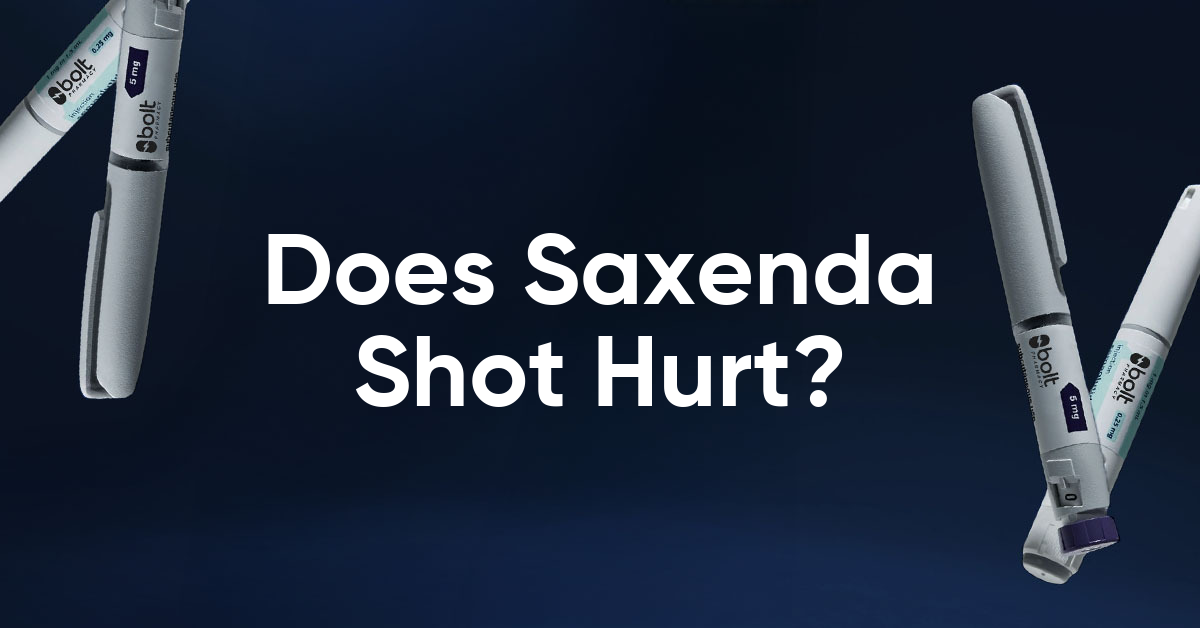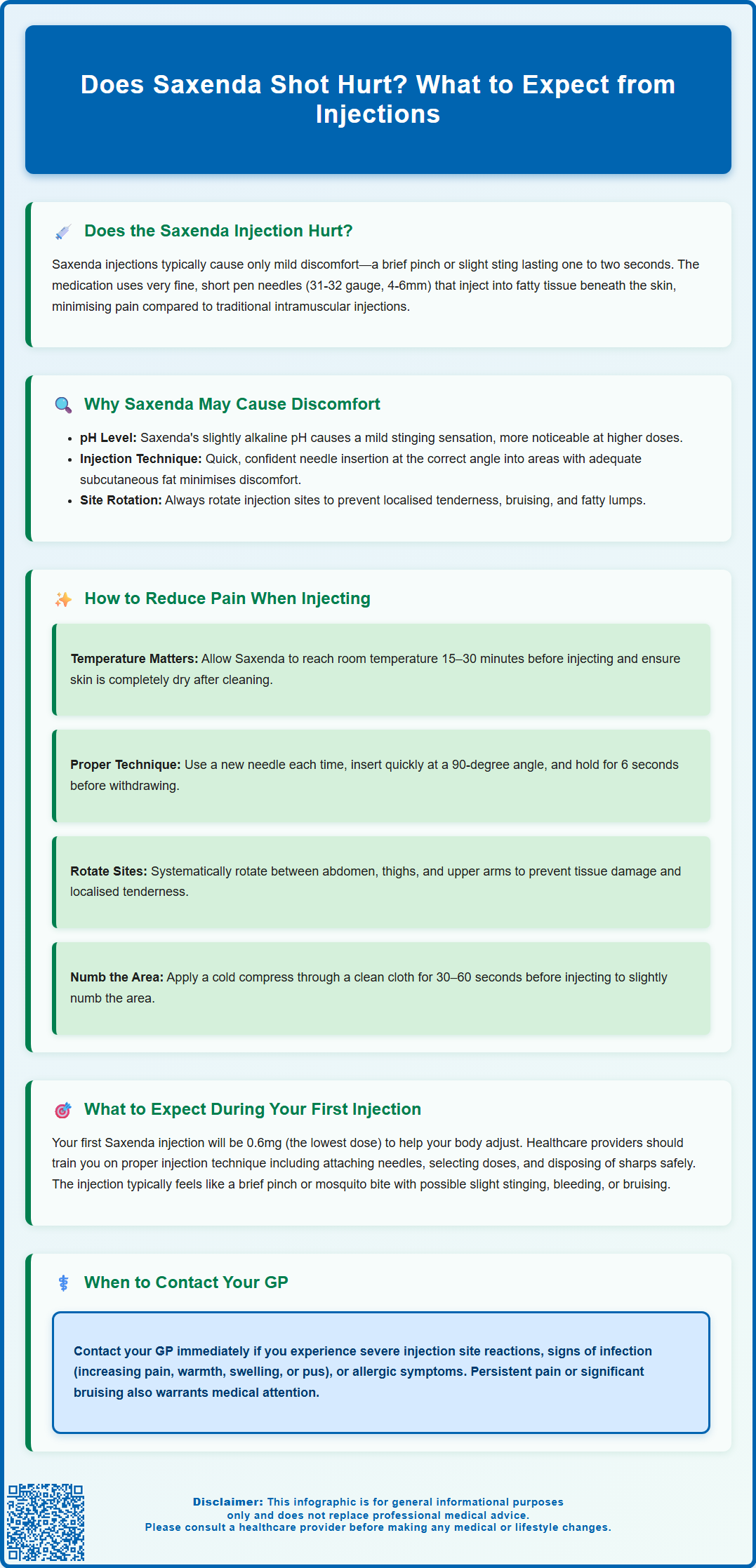Wegovy®
A weekly GLP-1 treatment proven to reduce hunger and support meaningful, long-term fat loss.
- ~16.9% average body weight loss
- Boosts metabolic & cardiovascular health
- Proven, long-established safety profile
- Weekly injection, easy to use

Does Saxenda shot hurt? Many people considering Saxenda (liraglutide) for weight management understandably worry about injection discomfort. The good news is that most patients find Saxenda injections relatively tolerable. The treatment uses a very fine, short pen needle designed to minimise pain during administration. Because Saxenda is injected into subcutaneous tissue—the fatty layer beneath the skin—rather than muscle, the sensation is typically mild. Most people describe it as a brief pinch or slight sting lasting only seconds. Individual experiences vary, but proper injection technique and simple comfort measures can significantly reduce any discomfort. This article explores what to expect and how to make your Saxenda injections as comfortable as possible.
Summary: Saxenda injections typically cause minimal discomfort, with most patients describing a brief pinch or slight sting lasting only seconds.
Saxenda (liraglutide) is a subcutaneous injection used for weight management in adults with obesity or overweight with weight-related comorbidities. Many people considering this treatment naturally wonder about injection-related discomfort. Most patients find Saxenda injections relatively tolerable, though experiences vary between individuals.
The injection uses a very fine, short pen needle (typically 31-32 gauge, 4-6mm length) designed to minimise discomfort during administration. Because Saxenda is injected into the subcutaneous tissue—the fatty layer just beneath the skin rather than into muscle—the sensation is typically mild. Most patients describe it as a brief pinch or slight sting that lasts only a second or two. Some people report feeling virtually nothing at all, whilst others may experience slightly more noticeable discomfort, particularly when first starting treatment.
Individual pain perception varies considerably and depends on several factors including injection technique, site selection, needle sharpness, and personal pain threshold. It's worth noting that any discomfort experienced is generally far less significant than the pain associated with traditional intramuscular injections. The pre-filled pen device is designed for ease of use and incorporates features that help reduce injection anxiety.
For patients with needle phobia or heightened sensitivity, it's important to discuss concerns with your prescribing clinician or practice nurse. They can provide hands-on training and demonstrate proper technique according to the Patient Information Leaflet (PIL), which significantly influences comfort levels. The abdomen or thigh are the usual injection sites; upper arm injections may require assistance to avoid intramuscular injection. Most patients find that any initial apprehension diminishes quickly once they become familiar with the injection routine, and the minor discomfort becomes a manageable part of their weight management journey.

Understanding the potential sources of injection discomfort can help patients minimise pain and improve their injection experience. Several factors contribute to the sensation felt during Saxenda administration, ranging from the physical properties of the medication to technique-related variables.
The medication itself can cause a mild stinging sensation as it enters the subcutaneous tissue. Saxenda has a slightly alkaline pH compared to the body's natural pH. This difference can create a brief burning or stinging feeling as the solution disperses under the skin. Additionally, the volume injected increases as you progress through dose escalation—starting at 0.6mg and potentially reaching 3.0mg daily—which means more fluid entering the tissue and potentially more noticeable sensation at higher doses.
Injection technique plays a crucial role in comfort levels. Slow or hesitant needle insertion, using the wrong angle, or injecting into areas with less subcutaneous fat can increase discomfort. Injecting into the same site repeatedly may cause localised tenderness, bruising, or the development of lipohypertrophy (fatty lumps), all of which make subsequent injections more uncomfortable. Cold medication straight from the refrigerator can also intensify the stinging sensation.
Other contributing factors include:
Dull or damaged needles – Always use a fresh needle for each injection
Tense muscles – Anxiety or muscle tension in the injection area increases pain perception
Injection speed – Pushing the medication in too rapidly can cause pressure-related discomfort
Skin conditions – Injecting through irritated, inflamed, or broken skin increases pain
Individual anatomical differences also matter. People with less subcutaneous fat may find certain injection sites more uncomfortable, whilst those with more adipose tissue typically experience less sensation. Do not inject into areas that are tender, bruised, scarred, hardened, or lumpy. Always rotate injection sites to maintain skin health and reduce discomfort.
Implementing evidence-based strategies can significantly reduce injection-related discomfort and help patients maintain adherence to their Saxenda regimen. The following techniques are recommended by healthcare professionals and supported by patient experience.
Preparation is key to comfortable injections. Remove Saxenda from the refrigerator 15–30 minutes before injecting to allow it to reach room temperature, as cold medication causes more stinging. Ensure your skin is clean; soap and water usually suffice, though if using an alcohol wipe, allow the skin to dry completely—injecting through wet alcohol can cause a sharp burning sensation. Check that you're using a new, sterile needle for each injection, as reusing needles causes them to become dull and barbed, increasing pain and infection risk.
Proper injection technique makes a substantial difference:
Rotate injection sites systematically between the abdomen, thighs, and upper arms to prevent tissue damage and localised tenderness
Pinch the skin gently to create a fold of subcutaneous tissue if you are very lean or if advised by your clinician; otherwise, 4mm needles can often be used at 90° without a skinfold
Insert the needle at a 90-degree angle with a quick, smooth motion rather than pushing slowly
Press the dose button until the counter shows 0 and keep the needle in the skin for 6 seconds to ensure complete dose delivery
Withdraw the needle at the same angle it was inserted
Do not rub or massage the injection site afterwards
Additional comfort measures include applying a cold compress to the injection site for 30–60 seconds before injecting to numb the area slightly (use through a clean cloth and avoid direct ice on skin). Practising relaxation techniques such as deep breathing during injection can reduce muscle tension and pain perception.
After injecting, remove the needle immediately and dispose of it in a sharps bin, which can be obtained from your GP, pharmacy, or local council. Never store the pen with a needle attached, and never share pens or needles.
If you experience persistent pain, significant bruising, or injection site reactions, consult your GP or prescribing clinician. They can review your technique and ensure there are no underlying issues requiring attention. Report any suspected side effects via the MHRA Yellow Card Scheme (yellowcard.mhra.gov.uk).
Starting Saxenda treatment involves a learning curve, and knowing what to expect can reduce anxiety and improve your initial experience. Your first injection will typically be administered at a dose of 0.6mg, which is the lowest starting dose designed to help your body adjust to the medication whilst minimising gastrointestinal side effects.
Before your first injection, your healthcare provider or practice nurse should provide comprehensive training on proper injection technique using the Saxenda pen device. This hands-on instruction is invaluable and typically includes demonstration of how to attach a new needle, select the correct dose, perform the injection, and safely dispose of used needles in a sharps container. Don't hesitate to ask questions or request a second demonstration—confidence in technique directly correlates with reduced discomfort and better adherence.
During the actual first injection, you may feel more nervous than you will for subsequent doses, which can heighten pain perception. Most patients report that the anticipation is worse than the reality. The sensation is typically described as a brief pinch or mosquito bite—momentary and manageable. You might notice a slight stinging as the medication enters the tissue, which usually subsides within seconds. Some people experience a small amount of bleeding or bruising at the injection site, which is normal and not cause for concern. If slight bleeding occurs, apply gentle pressure with clean gauze for a few seconds; do not rub.
In the hours following your first injection, monitor for common side effects including nausea, which affects a significant proportion of patients initially but typically improves with continued use. Injection site reactions such as mild redness, itching, or a small lump under the skin may occur but generally resolve quickly. These are usually related to the medication rather than the injection technique itself.
Keep a record of your injection sites and any reactions to discuss with your healthcare provider at follow-up appointments. Always check that the solution is clear and colourless before injecting; do not use if cloudy, coloured, or contains particles. Remember that Saxenda is prescribed as part of a comprehensive weight management programme including reduced-calorie diet and increased physical activity. Your prescriber will schedule regular reviews to monitor your progress, adjust dosing according to the escalation schedule, and address any concerns. If you experience severe injection site reactions, signs of infection (increasing pain, warmth, swelling, or pus), or allergic symptoms, contact your GP promptly.
Saxenda injections are generally less painful than intramuscular injections because they use very fine needles (31-32 gauge) and are administered into subcutaneous tissue rather than muscle. Most patients describe the sensation as a brief pinch or mosquito bite lasting only seconds.
Yes, several techniques reduce discomfort: allow Saxenda to reach room temperature before injecting, rotate injection sites systematically, use a new needle each time, insert the needle quickly at 90 degrees, and ensure skin is completely dry before injection. Applying a cold compress beforehand can also help numb the area slightly.
Contact your GP if you experience persistent pain at injection sites, significant bruising, signs of infection (increasing pain, warmth, swelling, or pus), severe injection site reactions, or allergic symptoms. Your healthcare provider can review your technique and ensure no underlying issues require attention.
The health-related content published on this site is based on credible scientific sources and is periodically reviewed to ensure accuracy and relevance. Although we aim to reflect the most current medical knowledge, the material is meant for general education and awareness only.
The information on this site is not a substitute for professional medical advice. For any health concerns, please speak with a qualified medical professional. By using this information, you acknowledge responsibility for any decisions made and understand we are not liable for any consequences that may result.
Lorem ipsum dolor sit amet, consectetur adipiscing elit, sed do eiusmod tempor incididunt ut labore et dolore magna aliqua. Ut enim ad minim veniam, quis nostrud exercitation ullamco laboris nisi ut aliquip ex ea commodo consequat. Duis aute irure dolor in reprehenderit in voluptate velit esse cillum dolore eu fugiat nulla pariatur.
Block quote
Ordered list
Unordered list
Bold text
Emphasis
Superscript
Subscript